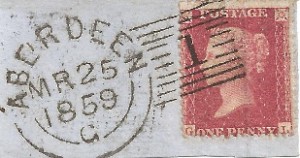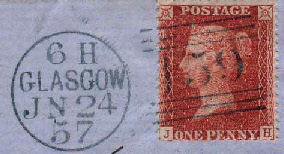Introduction
The huge increase in the volume of mail in Great Britain during the mid 19th century focused the Postal Authorities’ minds on ways of speeding up the stamping processes whilst at the same time keeping the costs to a minimum. This was prior to machinery being brought in to aid the process.
The Authorities were paranoid about the possibility of fraud by postage stamps being reused whilst at the same time they were extremely sensitive to complaints by the general public of postage delays (unlike the present time!). Therefore there had to be clarity in the dates whilst ensuring the stamp was properly cancelled.
The cancelling method was straight forward; subsequent to 1844 the postage stamp was cancelled by a numeral surrounded by bars (each of England and Wales, Ireland and Scotland had their different formats) which had been allocated to the particular dispatch Town. An additional postmark was applied to the reverse of the envelope (usually) showing the date and the dispatch Town name. The receiving Town then applied its own backstamp evidencing the date of receipt.
Some bright spark in the Postal Authorities decided that the first process could be speeded up by the application of a Double Stamp which incorporated an element showing the Town, Date and Time/Duty Code together with an element containing the cancelling portion ‘the killer’. This could be accomplished by one blow to the envelope rather than two as previously.
Whilst today this might seem to be an obvious development it was not so clear cut in the 1850’s; the heavier handstamp created a slower process (stampers were expected to cancel some 100+ envelopes a minute) with the possibility of damage to the envelope.
The first known use of a Double Stamp (hereinafter referred to as a ‘Duplex’) was in London in early 1853 but thereafter the ‘experiment’ exploded into life with trials taking place in several hundred Towns over the next 5 years or so. Collectors have classified these first Duplex Postmarks as either ‘Spoons or ‘Sideways Duplex’ for those issued in England, Wales and Ireland.
Trials of the new Duplex postmarks in Scotland were for some reason delayed until mid 1855 (Leith being the first albeit of an unorthodox design) and were issued to only twelve Towns namely Aberdeen, Dumfries, Dundee, Edinburgh, Glasgow, Greenock, Inverness, Kilmarnock, Leith, Paisley, Perth and Stirling.
All of the dies were manufactured by Alexander Kirkwood and Son of Edinburgh.
Some of the Towns used their new Duplex handstamps on a regular basis e.g. Aberdeen over a nine year period and Perth over a five year period. This contrasted with Edinburgh who used theirs very infrequently over a two year period and Kilmarnock again infrequently over eighteen months.
The quality of the cancellations was mixed thus potentially negating one of the main objectives of the Duplex stamps although this did vary from Town to Town perhaps therefore pointing the finger at the quality of the Stampers rather than the handstamps.
The finally adopted Scottish Duplex Postmarks (1857 onwards) were not hugely dissimilar to the Experimental marks with the main differentiating characteristic being that the latter has short horizontal bars either side of the Town numeral whereas the former does not (see below). In some Towns the different types of marks were used side by side for quite a few years, obviously conserving their pennies.
Typical Experimental Style Typical Subsequent Duplex Style
Town Types
Information on the different Types can be accessed by clicking on the Menu at the top of this page. This will lead to individual Town pages which incorporate a Picture Gallery, click on a picture to expand it. Please note that the Pictures/Diagrams are not necessarily to scale and thus measurements are unsafe. For the ‘base’ postmarks I have shown the Proof mark (where possible) and with later ‘states’ I have provided my own picture.
Recuts
This has been somewhat of a dilemma for me as to how I should express these ‘varieties’. The practical problem is that often the Proof Books (not just Scottish) are unclear as to whether the mark shown is New or a Recut. In a minority of cases they do.
Therefore I have decided to take the following approach (which basically follows the accepted practice in the Spoons books).
Where there is obvious change in the design then this will be designated a new Type whether or not it resulted from a Recut.
Where there is no obvious change in the design but the Proof Books show an additional entry (not just the provision of new Code/Date slugs) then this will be designated as a Recut e.g. Type 1 Recut 1, Type 1 Recut 2 etc. This will be spelt out under the description of each Type.
Damaged Dies (i.e. Later ‘States’)
During the hard working life of the handstamps, damage occurred which was rarely corrected except via a subsequent Recut.
This is evident by the appearance of visible constant varieties (not just ‘fly specks’ ) and, where known are designated as further ‘States’. Full details (and diagrams) of the damage in chronological order are shown under each Type. Dundee is a particular example where there are, so far, seven States (including the original –
At first this may seem unduly complicated but looking at actual examples is the best way forward.
Codes and Months of Use
As I have now accumulated a significant database I am now including the numbers I have seen for each Month of Use and each Code to provide a further measure of scarcity. The only problem with this is that I will have to update the site each time I see a new example!
The more observant of you may well notice that the aggregate number of examples shown in Codes is often less than the aggregate number shown in Months. This is simply because the Code is occasionally blurred/faint and as such has not been included.
Apart from the early Edinburgh and Glasgow (Madeleine Smith) marks all Towns showed one Code only which in the majority of cases was a letter. This Code is assumed to represent a particular Duty/Time and I have no reason to doubt this. Any mark which bears a second letter/figure is assumed to refer to the individual Stamper who would have signed in for his (all males then!) handstamp at the beginning of his shift.
Just a comment on Codes; it is sometimes difficult to differentiate between certain letters e.g. ‘C’ and ‘G’ –
The norm was for all cancellations to be applied in black. However, there are certain exceptions and these will be mentioned against each type where applicable.
Scarcity
It should be appreciated that ALL Scottish Experimental Postmarks are relatively uncommon when compared with the majority of the subsequent Duplex marks. However, there are huge differences in prices; an Aberdeen Experimental on cover can be picked up for less that ten pounds whereas one of the Edinburgh marks may well cost several thousand pounds!
As mentioned on my Home page, I have applied the following Scarcity Ratings to each Type and, where relevant, each State:
Scarcity Rating
A: Abundant
B: Common
C: Average
D: Not Common
E: Scarce
F: Rare
G: Very Rare
H: Very Few Exist
H*: Recorded on Stamp Only
GPO: Proof Book Entry Only
Having said the above, for Scottish Experimentals only a few of these ratings will be used; e.g. NONE of these postmarks are abundant or common!!
A big caveat; there may be some marks that are rarely seen and then suddenly a ‘town collector’ puts a collection on the market, e.g. up until last year I had scans of only 5 Greenock Type 1. I then received scans of a further 23 examples from a single collector!!. This is still a Scarce postmark (albeit I am now up to 39 examples recorded) but be warned, there are pockets of non recorded items out there!!
Attribution
There has really only been one major documented study of these Postmarks and that is Experimental Duplex Cancellations of Scotland published by the Scottish Postmark Group (SPG) in 1963; a fine book (albeit long out of print) which does not need a huge amount of updating even after 50 years.
In addition I have drawn information and been provided with many examples from the following sources for which I am most grateful. I trust this list will continue to expand.
Scottish Postmarks by James Mackay
Scottish Numeral Postmarks by James Mackay
British Postal Museum & Archives
Grosvenor Auctions
Cavendish Auctions
John Tingey, Doug McGill, Brian Perrett, Mike Williams, Alan Johnson, Rod Paige, Andrew Chappell, Andrew Ford, Keith Robinson, Brian Dow, Bruce Walker, Quentin Mair, Bill Barnes, Martin Kirkbride, Archie Stevenson, Tony Clarke, Michael Savage, Alan Thompson
Reproduction of the Kirkwood Proofs is with kind permission of the Scottish Postal History Society
Finally I would like to express my particular appreciation to Mike Raguin who has been kind enough to give me access to his superb collection. Much of what I have written in respect of the different Dundee States and the Glasgow (Madeleine Smith) different Types would not have been possible without his assistance.
Updates:
12th August 2015
20th January 2016
July 2020
November 2020
May 2021
December 2022


